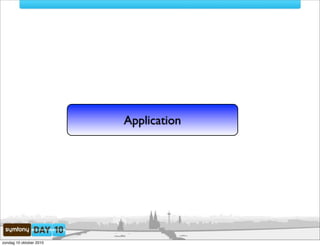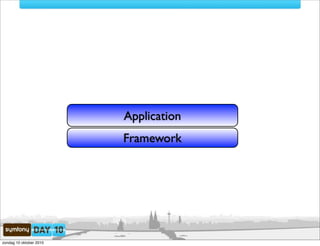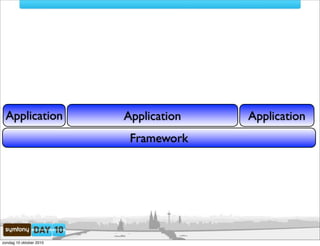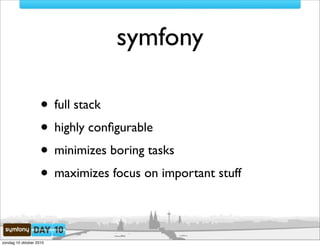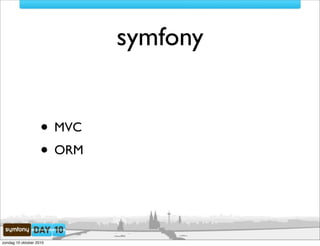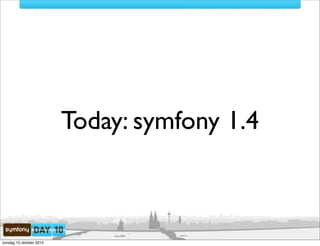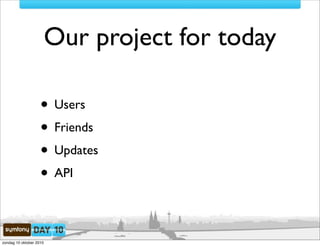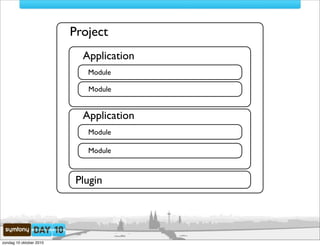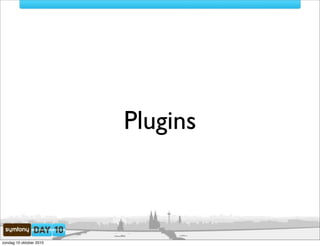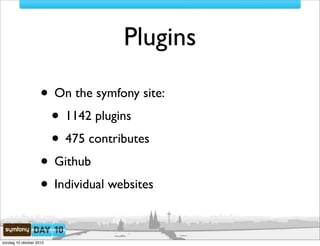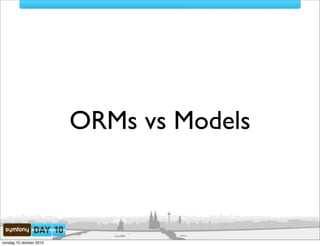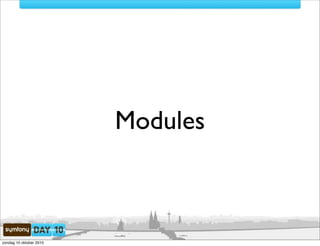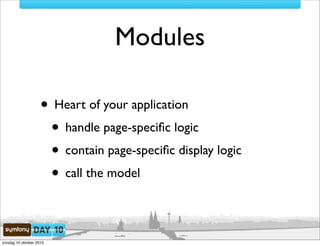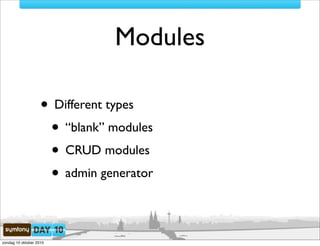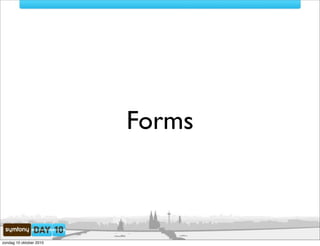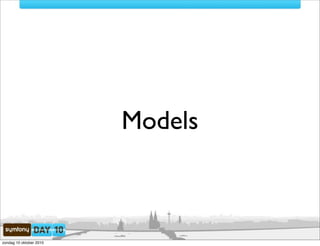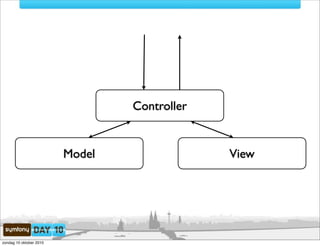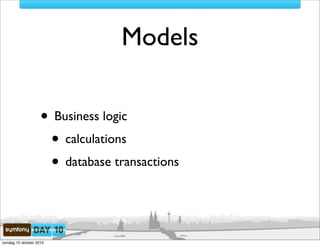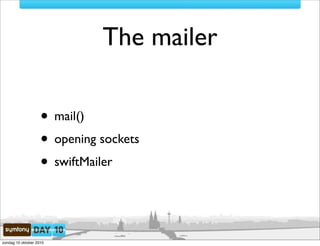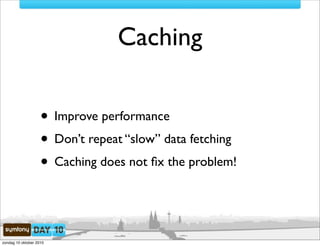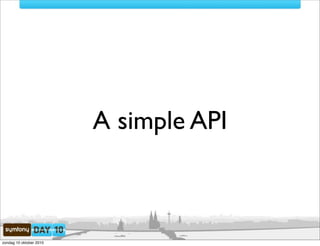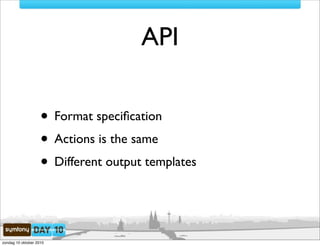symfony 1.4 workshop
- 1. Symfony workshop Stefan Koopmanschap zondag 10 oktober 2010
- 2. Welcome zondag 10 oktober 2010
- 3. Today ŌĆó Frameworks ŌĆó The symfony framework ŌĆó Developing with symfony ŌĆó Our project for today zondag 10 oktober 2010
- 4. Introduction ŌĆó Stefan Koopmanschap ŌĆó Software Engineer ŌĆó Consultant ŌĆó Trainer ŌĆó Community Manager ŌĆó PHPBenelux secretary zondag 10 oktober 2010
- 5. Frameworks zondag 10 oktober 2010
- 6. Application zondag 10 oktober 2010
- 7. Application Framework zondag 10 oktober 2010
- 8. Application Application Application Framework zondag 10 oktober 2010
- 9. symfony zondag 10 oktober 2010
- 10. symfony ŌĆó full stack ŌĆó highly con’¼ügurable ŌĆó minimizes boring tasks ŌĆó maximizes focus on important stuff zondag 10 oktober 2010
- 11. symfony ŌĆó MVC ŌĆó ORM zondag 10 oktober 2010
- 12. Today: symfony 1.4 zondag 10 oktober 2010
- 13. Developing with symfony ŌĆó symfony ŌĆó PHP and a webserver (and a database) ŌĆó command line ŌĆó IDE zondag 10 oktober 2010
- 14. Our project for today ŌĆó Users ŌĆó Friends ŌĆó Updates ŌĆó API zondag 10 oktober 2010
- 15. Gesichtbuch zondag 10 oktober 2010
- 16. zondag 10 oktober 2010
- 17. Structure zondag 10 oktober 2010
- 18. Project Application Module Module Application Module Module Plugin zondag 10 oktober 2010
- 19. Plugins zondag 10 oktober 2010
- 20. Plugins ŌĆó reusable sets of functionality ŌĆó modules ŌĆó libraries ŌĆó anything that can be re-used zondag 10 oktober 2010
- 21. Plugins ŌĆó On the symfony site: ŌĆó 1142 plugins ŌĆó 475 contributes ŌĆó Github ŌĆó Individual websites zondag 10 oktober 2010
- 22. sfDoctrineGuardPlugin ŌĆó Authentication ŌĆó Authorization ŌĆó User management zondag 10 oktober 2010
- 23. zondag 10 oktober 2010
- 24. The database zondag 10 oktober 2010
- 25. Database ŌĆó ORMs ŌĆó Propel ŌĆó Doctrine ŌĆó Custom zondag 10 oktober 2010
- 26. ORMs vs Models zondag 10 oktober 2010
- 27. zondag 10 oktober 2010
- 28. Modules zondag 10 oktober 2010
- 29. Modules ŌĆó Heart of your application ŌĆó handle page-speci’¼üc logic ŌĆó contain page-speci’¼üc display logic ŌĆó call the model zondag 10 oktober 2010
- 30. Modules ŌĆó Different types ŌĆó ŌĆ£blankŌĆØ modules ŌĆó CRUD modules ŌĆó admin generator zondag 10 oktober 2010
- 31. zondag 10 oktober 2010
- 32. Forms zondag 10 oktober 2010
- 33. Forms ŌĆó Extensive integrated form framework ŌĆó Form generation ŌĆó Form validation ŌĆó Form processing zondag 10 oktober 2010
- 34. zondag 10 oktober 2010
- 35. Models zondag 10 oktober 2010
- 36. Controller Model View zondag 10 oktober 2010
- 37. Models ŌĆó Business logic ŌĆó calculations ŌĆó database transactions zondag 10 oktober 2010
- 38. zondag 10 oktober 2010
- 39. The mailer zondag 10 oktober 2010
- 40. The mailer ŌĆó mail() ŌĆó opening sockets ŌĆó swiftMailer zondag 10 oktober 2010
- 41. zondag 10 oktober 2010
- 42. Caching zondag 10 oktober 2010
- 43. Caching ŌĆó Improve performance ŌĆó DonŌĆÖt repeat ŌĆ£slowŌĆØ data fetching ŌĆó Caching does not ’¼üx the problem! zondag 10 oktober 2010
- 44. Caching in symfony ŌĆó Con’¼üguration mostly ŌĆó Coding is possible zondag 10 oktober 2010
- 45. zondag 10 oktober 2010
- 46. Routing zondag 10 oktober 2010
- 47. Routing ŌĆó gesichtbuch.de/users/id/1 ŌĆó gesichtbuch.de/users/stefan ŌĆó gesichtbuch.de/stefan zondag 10 oktober 2010
- 48. zondag 10 oktober 2010
- 49. A simple API zondag 10 oktober 2010
- 50. API ŌĆó Format speci’¼ücation ŌĆó Actions is the same ŌĆó Different output templates zondag 10 oktober 2010
- 51. zondag 10 oktober 2010
- 52. Play more... zondag 10 oktober 2010






